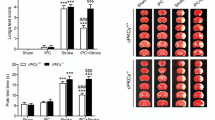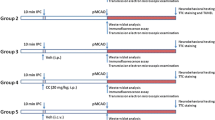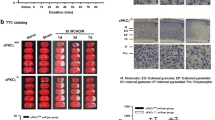Abstract
The ataxia-telangiectasia mutated (ATM) protein is regarded as the linchpin of cellular defenses to stress. Deletion of ATM results in strong oxidative stress and degenerative diseases in the nervous system. However, the role of ATM in neuronal ischemic preconditioning and lethal ischemic injury is still largely unknown. In this study, mice cortical neurons preconditioned with sublethal exposure to oxygen glucose deprivation (OGD) exhibited ATM/glucose-6-phosphate dehydrogenase pathway activation. Additionally, pharmacological inhibition of ATM prior to the preconditioning reversed neuroprotection provided by preconditioning in vitro and in vivo. Meanwhile, we found that ATM/P53 pro-apoptosis pathway was driven by lethal OGD injury, and pharmacological inhibition of ATM during fatal oxygen–glucose deprivation/reperfusion injury promoted neuronal survival. More importantly, inhibition of ATM activity after cerebral ischemia protected against cerebral ischemic-reperfusion damage in mice. In conclusion, our data show the dual role of ATM in neuronal ischemic preconditioning and lethal ischemic injury, involving in the protection of ischemic preconditioning, but promoting neuronal death in lethal ischemic injury. Thus, the present study provides new opportunity for the treatment of ischemic stroke.






Similar content being viewed by others
Abbreviations
- ATM:
-
Ataxia-telangiectasia mutated
- OGD:
-
Oxygen glucose deprivation
- DSBs:
-
Double-strand breaks
- HIF-1:
-
Hypoxia-inducible factor 1
- PC:
-
Preconditioning
- NADPH:
-
Nicotinamide adenine dinucleotide phosphate
- GSH:
-
Glutathione
- MCAO:
-
Middle cerebral artery occlusion
- HDAC4:
-
Histone deacetylase 4
- CREB:
-
CAMP-response element binding protein
- TTC:
-
2,3,5-Triphenyltetrazolium chloride
- TUNEL:
-
Terminal deoxynucleotidyl transferase (TdT)-mediated dUTP nick end labeling
- G6PD:
-
Glucose-6-phosphate dehydrogenase
- γ-H2AX:
-
Phosphorylated Histone H2AX
References
Ambrose M, Goldstine JV, Gatti RA (2007) Intrinsic mitochondrial dysfunction in ATM-deficient lymphoblastoid cells. Hum Mol Genet 16(18):2154–2164. https://doi.org/10.1093/hmg/ddm166
Baines CP, Goto M, Downey JM (1997) Oxygen radicals released during ischemic preconditioning contribute to cardioprotection in the rabbit myocardium. J Mol Cell Cardiol 29(1):207–216. https://doi.org/10.1006/jmcc.1996.0265
Bhatti S, Kozlov S, Farooqi AA, Naqi A, Lavin M, Khanna KK (2011) ATM protein kinase: the linchpin of cellular defenses to stress. Cell Mol Life Sci 68(18):2977–3006. https://doi.org/10.1007/s00018-011-0683-9
Biton S, Barzilai A, Shiloh Y (2008) The neurological phenotype of ataxia-telangiectasia: solving a persistent puzzle. DNA Repair 7(7):1028–1038. https://doi.org/10.1016/j.dnarep.2008.03.006
Cam H, Easton JB, High A, Houghton PJ (2010) mTORC1 signaling under hypoxic conditions is controlled by ATM-dependent phosphorylation of HIF-1alpha. Mol Cell 40(4):509–520. https://doi.org/10.1016/j.molcel.2010.10.030
Cao L, Zhang D, Chen J, Qin YY, Sheng R, Feng X, Chen Z, Ding Y, Li M, Qin ZH (2017) G6PD plays a neuroprotective role in brain ischemia through promoting pentose phosphate pathway. Free Radic Biol Med 112:433–444. https://doi.org/10.1016/j.freeradbiomed.2017.08.011
Choy KR, Watters DJ (2018) Neurodegeneration in ataxia-telangiectasia: Multiple roles of ATM kinase in cellular homeostasis. Dev Dyn 247(1):33–46. https://doi.org/10.1002/dvdy.24522
Cosentino C, Grieco D, Costanzo V (2011) ATM activates the pentose phosphate pathway promoting anti-oxidant defence and DNA repair. EMBO J 30(3):546–555. https://doi.org/10.1038/emboj.2010.330
Derheimer FA, Kastan MB (2010) Multiple roles of ATM in monitoring and maintaining DNA integrity. FEBS Lett 584(17):3675–3681. https://doi.org/10.1016/j.febslet.2010.05.031
Ditch S, Paull TT (2012) The ATM protein kinase and cellular redox signaling: beyond the DNA damage response. Trends Biochem Sci 37(1):15–22. https://doi.org/10.1016/j.tibs.2011.10.002
Doerfler A, Schwab S, Hoffmann TT, Engelhorn T, Forsting M (2001) Combination of decompressive craniectomy and mild hypothermia ameliorates infarction volume after permanent focal ischemia in rats. Stroke 32(11):2675–2681. https://doi.org/10.1161/hs1101.098369
Feng Z, Levine AJ (2010) The regulation of energy metabolism and the IGF-1/mTOR pathways by the p53 protein. Trends Cell Biol 20(7):427–434. https://doi.org/10.1016/j.tcb.2010.03.004
Frappart PO, McKinnon PJ (2006) Ataxia-telangiectasia and related diseases. Neuromol Med 8(4):495–511. https://doi.org/10.1385/NMM:8:4:495
Geng J, Zhang Y, Li S, Li S, Wang J, Wang H, Aa J, Wang G (2019) Metabolomic Profiling Reveals That Reprogramming of Cerebral Glucose Metabolism Is Involved in Ischemic Preconditioning-Induced Neuroprotection in a Rodent Model of Ischemic Stroke. J Proteome Res 18(1):57–68. https://doi.org/10.1021/acs.jproteome.8b00339
Guo Z, Deshpande R, Paull TT (2010a) ATM activation in the presence of oxidative stress. Cell Cycle 9(24):4805–4811. https://doi.org/10.4161/cc.9.24.14323
Guo Z, Kozlov S, Lavin MF, Person MD, Paull TT (2010b) ATM activation by oxidative stress. Science 330(6003):517–521. https://doi.org/10.1126/science.1192912
Imahori T, Hosoda K, Nakai T, Yamamoto Y, Irino Y, Shinohara M, Sato N, Sasayama T, Tanaka K, Nagashima H, Kohta M, Kohmura E (2017) Combined metabolic and transcriptional profiling identifies pentose phosphate pathway activation by HSP27 phosphorylation during cerebral ischemia. Neuroscience 349:1–16. https://doi.org/10.1016/j.neuroscience.2017.02.036
Jeng W, Loniewska MM, Wells PG (2013) Brain glucose-6-phosphate dehydrogenase protects against endogenous oxidative DNA damage and neurodegeneration in aged mice. ACS Chem Neurosci 4(7):1123–1132. https://doi.org/10.1021/cn400079y
Jung CG, Uhm KO, Miura Y, Hosono T, Horike H, Khanna KK, Kim MJ, Michikawa M (2011) Beta-amyloid increases the expression level of ATBF1 responsible for death in cultured cortical neurons. Mol Neurodegener 6:47. https://doi.org/10.1186/1750-1326-6-47
Kalogeris T, Bao Y, Korthuis RJ (2014) Mitochondrial reactive oxygen species: a double edged sword in ischemia/reperfusion vs preconditioning. Redox Biol 2:702–714. https://doi.org/10.1016/j.redox.2014.05.006
Kamsler A, Daily D, Hochman A, Stern N, Shiloh Y, Rotman G, Barzilai A (2001) Increased oxidative stress in ataxia telangiectasia evidenced by alterations in redox state of brains from Atm-deficient mice. Cancer Res 61(5):1849–1854
Kim TS, Kawaguchi M, Suzuki M, Jung CG, Asai K, Shibamoto Y, Lavin MF, Khanna KK, Miura Y (2010) The ZFHX3 (ATBF1) transcription factor induces PDGFRB, which activates ATM in the cytoplasm to protect cerebellar neurons from oxidative stress. Dis Model Mech 3(11–12):752–762. https://doi.org/10.1242/dmm.004689
Kruman II, Wersto RP, Cardozo-Pelaez F, Smilenov L, Chan SL, Chrest FJ, Emokpae R Jr, Gorospe M, Mattson MP (2004) Cell cycle activation linked to neuronal cell death initiated by DNA damage. Neuron 41(4):549–561
Kuang X, Yan M, Ajmo JM, Scofield VL, Stoica G, Wong PK (2012) Activation of AMP-activated protein kinase in cerebella of Atm-/- mice is attributable to accumulation of reactive oxygen species. Biochem Biophys Res Commun 418(2):267–272. https://doi.org/10.1016/j.bbrc.2012.01.008
Kuo LJ, Yang LX (2008) Gamma-H2AX - a novel biomarker for DNA double-strand breaks. In Vivo 22(3):305–309
Lee Y, McKinnon PJ (2007) Responding to DNA double strand breaks in the nervous system. Neuroscience 145(4):1365–1374. https://doi.org/10.1016/j.neuroscience.2006.07.026
Li W, Luo Y, Zhang F, Signore AP, Gobbel GT, Simon RP, Chen J (2006) Ischemic preconditioning in the rat brain enhances the repair of endogenous oxidative DNA damage by activating the base-excision repair pathway. J Cereb Blood Flow Metab 26(2):181–198. https://doi.org/10.1038/sj.jcbfm.9600180
Li N, Wu H, Yang S, Chen D (2007) Ischemic preconditioning induces XRCC1, DNA polymerase-beta, and DNA ligase III and correlates with enhanced base excision repair. DNA Repair 6(9):1297–1306. https://doi.org/10.1016/j.dnarep.2007.02.027
Li J, Chen J, Ricupero CL, Hart RP, Schwartz MS, Kusnecov A, Herrup K (2012a) Nuclear accumulation of HDAC4 in ATM deficiency promotes neurodegeneration in ataxia telangiectasia. Nat Med 18(5):783–790. https://doi.org/10.1038/nm.2709
Li Y, Xiong H, Yang DQ (2012b) Functional switching of ATM: sensor of DNA damage in proliferating cells and mediator of Akt survival signal in post-mitotic human neuron-like cells. Chin J Cancer 31(8):364–372. https://doi.org/10.5732/cjc.012.10086
Lin WY, Chang YC, Lee HT, Huang CC (2009) CREB activation in the rapid, intermediate, and delayed ischemic preconditioning against hypoxic-ischemia in neonatal rat. J Neurochem 108(4):847–859. https://doi.org/10.1111/j.0022-3042.2008.05828.x
Obacz J, Pastorekova S, Vojtesek B, Hrstka R (2013) Cross-talk between HIF and p53 as mediators of molecular responses to physiological and genotoxic stresses. Mol Cancer 12(1):93. https://doi.org/10.1186/1476-4598-12-93
Ousset M, Bouquet F, Fallone F, Biard D, Dray C, Valet P, Salles B, Muller C (2010) Loss of ATM positively regulates the expression of hypoxia inducible factor 1 (HIF-1) through oxidative stress: Role in the physiopathology of the disease. Cell Cycle 9(14):2814–2822. https://doi.org/10.4161/cc.9.14.12248
Patel AY, McDonald TM, Spears LD, Ching JK, Fisher JS (2011) Ataxia telangiectasia mutated influences cytochrome c oxidase activity. Biochem Biophys Res Commun 405(4):599–603. https://doi.org/10.1016/j.bbrc.2011.01.075
Pei L, Shang Y, Jin H, Wang S, Wei N, Yan H, Wu Y, Yao C, Wang X, Zhu LQ, Lu Y (2014) DAPK1-p53 interaction converges necrotic and apoptotic pathways of ischemic neuronal death. J Neurosci 34(19):6546–6556. https://doi.org/10.1523/JNEUROSCI.5119-13.2014
Roos WP, Kaina B (2006) DNA damage-induced cell death by apoptosis. Trends Mol Med 12(9):440–450. https://doi.org/10.1016/j.molmed.2006.07.007
Shiloh Y (2003) ATM and related protein kinases: safeguarding genome integrity. Nat Rev Cancer 3(3):155–168. https://doi.org/10.1038/nrc1011
Tian B, Yang Q, Mao Z (2009) Phosphorylation of ATM by Cdk5 mediates DNA damage signalling and regulates neuronal death. Nat Cell Biol 11(2):211–218. https://doi.org/10.1038/ncb1829
Tu W, Xu X, Peng L, Zhong X, Zhang W, Soundarapandian MM, Balel C, Wang M, Jia N, Zhang W, Lew F, Chan SL, Chen Y, Lu Y (2010) DAPK1 interaction with NMDA receptor NR2B subunits mediates brain damage in stroke. Cell 140(2):222–234. https://doi.org/10.1016/j.cell.2009.12.055
Wang X, Pei L, Yan H, Wang Z, Wei N, Wang S, Yang X, Tian Q, Lu Y (2014) Intervention of death-associated protein kinase 1–p53 interaction exerts the therapeutic effects against stroke. Stroke 45(10):3089–3091. https://doi.org/10.1161/STROKEAHA.114.006348
Watters D, Kedar P, Spring K, Bjorkman J, Chen P, Gatei M, Birrell G, Garrone B, Srinivasa P, Crane DI, Lavin MF (1999) Localization of a portion of extranuclear ATM to peroxisomes. J Biol Chem 274(48):34277–34282
Wu J, Li J, Hu H, Liu P, Fang Y, Wu D (2012) Rho-kinase inhibitor, fasudil, prevents neuronal apoptosis via the Akt activation and PTEN inactivation in the ischemic penumbra of rat brain. Cell Mol Neurobiol 32(7):1187–1197. https://doi.org/10.1007/s10571-012-9845-z
Yamamoto Y, Hosoda K, Imahori T, Tanaka J, Matsuo K, Nakai T, Irino Y, Shinohara M, Sato N, Sasayama T, Tanaka K, Nagashima H, Kohta M, Kohmura E (2018) Pentose phosphate pathway activation via HSP27 phosphorylation by ATM kinase: A putative endogenous antioxidant defense mechanism during cerebral ischemia-reperfusion. Brain Res 1687:82–94. https://doi.org/10.1016/j.brainres.2018.03.001
Yang DQ, Halaby MJ, Li Y, Hibma JC, Burn P (2011) Cytoplasmic ATM protein kinase: an emerging therapeutic target for diabetes, cancer and neuronal degeneration. Drug Discov Today 16(7–8):332–338. https://doi.org/10.1016/j.drudis.2011.02.001
Zhang Y, Lee JH, Paull TT, Gehrke S, D'Alessandro A, Dou Q, Gladyshev VN, Schroeder EA, Steyl SK, Christian BE, Shadel GS (2018) Mitochondrial redox sensing by the kinase ATM maintains cellular antioxidant capacity. Sci Signal 11 (538): eaaq0702 https://doi.org/10.1126/scisignal.aaq0702
Acknowledgements
This research was funded by the National Nature Science Foundation of China (grant no. 81570417 to J.H.W.) and the Foundation of Health and Family Planning Commission of Hubei province (grant no. WJ2017H0026 to J.H.W).
Author information
Authors and Affiliations
Contributions
Experimental design: Jian-hua Wu; stroke model, stereotaxic injection, and writing of the article: Guang-hui Xie; TTC staining, western blotting, magnetic resonance imaging, immunofluorescence, Caspase-3 activity assay, G6PD activity assay, cell viability assay, and TUNEL staining: Han-jun Dai and Fang Liu; cell culture, NADPH/NADP+ and GSH/GSSC assay: Ying-pei Zhang; neurological score and rotarod treadmill test: Li Zhu; data analysis: Jun-jie Nie.
Corresponding author
Ethics declarations
Conflict of interest
The authors declare no conflict of interest.
Additional information
Publisher's Note
Springer Nature remains neutral with regard to jurisdictional claims in published maps and institutional affiliations.
Rights and permissions
About this article
Cite this article
Xie, Gh., Dai, Hj., Liu, F. et al. A Dual Role of ATM in Ischemic Preconditioning and Ischemic Injury. Cell Mol Neurobiol 40, 785–799 (2020). https://doi.org/10.1007/s10571-019-00773-6
Received:
Accepted:
Published:
Issue Date:
DOI: https://doi.org/10.1007/s10571-019-00773-6




